Sonicwall 03A TZ 150 Wireless / TZ 50 Wireless User Manual GSG TZ50 W 3 0 Draft a
Sonicwall, Inc. TZ 150 Wireless / TZ 50 Wireless GSG TZ50 W 3 0 Draft a
Users Manual

SonicWALL TZ 150 WIRELESS Internet Security
Appliance
Regulatory Statement and Safety Instructions
Regulatory Model/Type Product Name
APL15-03A TZ 150 WIRELESS
Class B Notice - Model APL15-03A
FCC Part 15 Class B Notice
NOTE: Models APL15-03A was tested and found to comply with the limits for
a Class B digital device, pursuant to Part 15 of the FCC Rules. These limits are designed to
provide reasonable protection against harmful interference in a residential installation. This
equipment generates, uses, and can radiate radio frequency energy. And, if not installed and
used in accordance with the instructions, may cause harmful interference to radio
communications. However, there is no guarantee that interference will not occur in a particular
installation. If the equipment does cause harmful interference to radio or television reception,
which can be determined by turning the equipment off and on, the user is encouraged to try
and correct the interference using one or more of the following measures:
• Reorient or relocate the receiving antenna.
• Increase the separation between the equipment and the receiver.
• Connect the equipment into an outlet on a circuit different from the receiver connection.
• Consult SonicWALL for assistance.
Complies with EN55022 Class B and CISPR22 Class B.
Refer to the label on the bottom of the unit for device information including Class A or Class B
FCC information.
Caution: Modifying this equipment or using this equipment for purposes not shown in this
manual without the written consent of SonicWALL, Inc. could void the user’s authority to
operate this equipment.
This device complies with Part 15 of the FCC Rules. Operation is subject to the following two
conditions: (1) This device may not cause harmful interference, and (2) this device must accept
any interference received, including interference that may cause undesired operation.
FCC RF Radiation Exposure Statement
This equipment complies with FCC RF radiation exposure limits set forth for an uncontrolled
environment. This equipment should be installed and operated with a minimum distance of 20
centimeters (7.9 inches) between the radiator (antenna) and your body.
This transmitter must not be co-located or operating in conjunction with any other antenna or
transmitter.
For more information regarding the above statement, please contact SonicWALL, Inc. at 1143
Borregas Avenue, Sunnyvale, CA 94089-1306 or 1-408-745-9600.
SonicWALL declares that the APL15-03A (FCC ID: QWU-03A) is limited in CH1~CH11 by specified
firmware controlled in the USA
Canada (IC):
To prevent radio interference to the licensed service, this device is intended to be operated
indoors and away from windows to provide maximum shielding. Equipment (or its transmit
antenna) that is installed outdoors is subject to licensing.
1.Operation is subject to the following two conditions:
1) this device may not cause interference and
2) this device must accept any interference, including interference that may cause undesired
operation of the device.
This device has been designed to operate with an antenna having a maximum gain of 0 dBD.
Antenna having a higher gain is strictly prohibited per regulations of Industry Canada.
Therequired antenna impedance is 50 ohms."
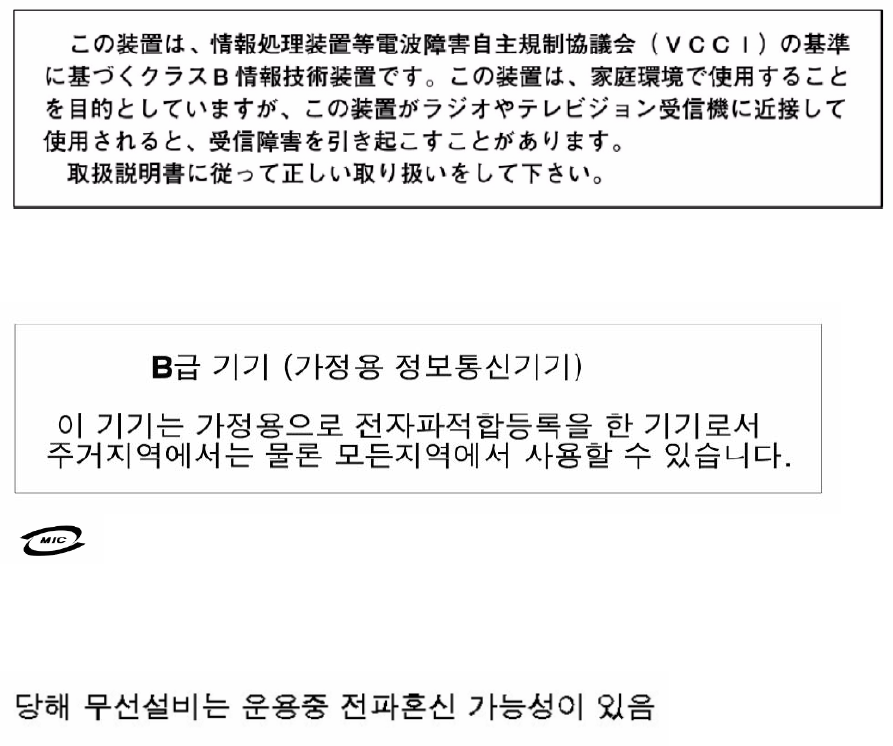
VCCI Statement
Regulatory Information for Korea
Ministry of Information and Telecommunication Certification Number
All products are made in Taiwan R.O.C.
All certificates held by NetSonic, Inc.
Canadian Radio Frequency Emissions Statement
This Class B digital apparatus complies with Canadian ICES-003.
Cet appareil numérique de la classe B est conforme à toutes la norme NMB-003 du Canada.
CISPR 22 (EN 55022) Class B
Declaration of Conformity
Application of council Directive 89/336/EEC (EMC) and
72/23/EEC (LVD)
Standards to which conformity is declared
EN55022 (1998) Class B
EN 55024 (1998) A1 (2001)
EN 61000-3-2 (2000)
EN 61000-3-3 (1995) A1 (2001)
EN 60950 (2000)
National Deviations: AT, AU, BE, CH, CN, CZ, DE, DK, FI, FR, GB, GR, HU, IE, IL, IN, IT, JP, KR, NL, NO, PL, SE, SG,
SI
EN 50371 (2002)
Directive 1999/5/EC (R&TTE) and standards
EN 301 489-1/-17 and EN 300 328-1/-2
Cable Connections - All Models
All Ethernet cables are designed for intra-building connection to other
equipment. Do not connect these ports directly to communication wiring or other wiring that
exits the building where the SonicWALL is located.
Power Supply Information - All Models
If the power supply is missing from your SonicWALL product package, please contact
SonicWALL Technical Support at 408-752-7819 for a replacement. This product should only be
used with a UL listed power supply marked “Class 2” or “LPS”, with an output rated 12 VDC,
minimum 1.66 A.
Wall Mounting the SonicWALL TZ 150 WIRELESS
You can mount your SonicWALL TZ 150 WIRELESS on a wall or any vertical surface. Use the
template on
the next page as a guide for placing the mounting screws.
1. Using the template on the next page, attach two screws to the surface where you want to
mount the security appliance.
The mounting screws should have a head between 3/16” and 1/4” in diameter.
The mounting screws should stick approximately 1/8” out from the surface.
2. Slide the slots in the back of the SonicWALL TZ 150 WIRELESS over the heads of the mounting
screws
and then slide the security appliance down to secure it in place.
Considerations for Mounting all Models
Mount in a location away from direct sunlight and sources of heat. A maximum ambient
temperature of 104º F (40º C) is recommended.
Route cables away from power lines, fluorescent lighting fixtures, and sources of noise such as
radios, transmitters, and broadband amplifiers
Ensure that no water or excessive moisture can enter the unit.
Allow unrestricted airflow around the unit and through the vents on the side of the unit. A
minimum of 1 inch (25.44mm) clearance is recommended.

SonicWALL TZ 150 Wireless Getting Started Guide Page 1
SonicWALL TZ 150 Wireless Security
Appliance Getting Started Guide
The SonicWALL® TZ 150 Wireless is a total security platform for both
your wired and wireless network, delivering true layered security by
integrating gateway anti-virus, intrusion prevention and content
filtering capabilities for small networks in an easy-to-use, low cost
platform.
This Getting Started Guide provides instructions for basic installation
and configuration of the SonicWALL TZ 150 Wireless. After you
complete this guide, up to 10 computers on your Local Area Network
(LAN) will have secure Internet access.
Note: For complete documentation, refer to the SonicWALL SonicOS
Standard 3.0 Administrator’s Guide on the SonicWALL Resource CD
or at: <http://www.sonicwall.com/services/documentation.html>.
Before You Begin
Check Package Contents
• One SonicWALL TZ 150 Wireless security appliance
• One SonicWALL TZ 150 Wireless Getting Started Guide
• One SonicOS Standard 3.0 Release Notes
• One Ethernet cable
• One 12V, 1.66A power supply
• One SonicWALL Resource CD, which contains product
documentation and software utilities.
Any Items Missing?
If any items are missing from your package, contact:
SonicWALL Support
Web: <http://www.sonicwall.com/support/>
E-mail: customer_service@sonicwall.com

Page 2
SonicWALL TZ 150 Wireless Configuration
“Collect Required Information” on page 3
“Applying Power to the SonicWALL TZ 150 Wireless” on
page 4
“Connecting the SonicWALL TZ 150 Wireless” on page 5
“Accessing the Management Interface” on page 6
“Using the SonicWALL Setup Wizard” on page 8
“Registering Your SonicWALL TZ 150 Wireless” on page 17
“Connecting Wireless Clients to the
SonicWALL TZ 150 Wireless” on page 22
“Connecting Computers to Your
SonicWALL TZ 150 Wireless” on page 26
What You Need to Begin
• A computer to use as a management station for initial
configuration of the SonicWALL TZ 150 Wireless
• An Internet connection
• A Web browser for accessing the SonicWALL TZ 150 Wireless’s
Web-based management interface. The Web browser must
support Java and HTTP uploads. Internet Explorer 5.0 or higher
or Netscape Navigator 4.7 or higher are recommended.
1
2
3
4
5
6
7
8

SonicWALL TZ 150 Wireless Getting Started Guide Page 3
Collect Required Information
Internet Service Provider (ISP) Information
Collect the following information about your Internet service:
Note: If you are not using one of the network configurations above,
refer to the SonicOS Standard Administrator’s Guide available on the
SonicWALL Resource CD and on the Web at:
<http://www.sonicwall.com/services/documentation.html>.
If you connect
via
You
probably
use
Please record
Cable modem,
DSL with a
router
DHCP You do not need to provide any Internet
connection information.
Home DSL PPPoE User Name:
Password:
Note: Your ISP may require your user
name in the format: name@ISP.com
T1,
Static
broadband,
Cable or DSL
with a static IP
Static IP IP Address:
Subnet Mask:
Default Gateway:
Primary DNS:
S e c o n d a r y D N S ( o p t i o n a l ) :
Dial in to a
server
PPTP Server Address:
User Name:
Password:
1
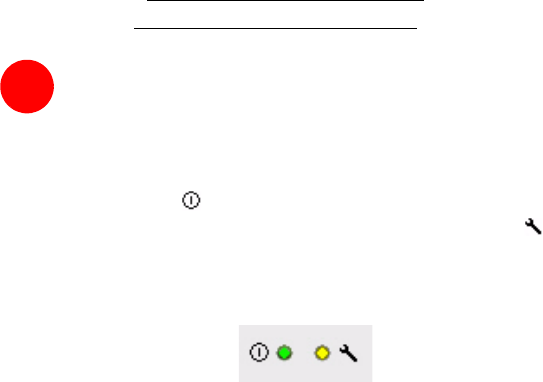
Page 4
Other Information
SonicWALL Management Interface
To access the SonicWALL TZ 150 Wireless Web-based
management interface. These are the default settings, which you
can change:
User Name: admin
Password: (default: password)
Applying Power to the
SonicWALL TZ 150 Wireless
1. Plug the power supply into the SonicWALL TZ 150 Wireless and
into an appropriate power outlet.
The Power LED on the front panel lights up green when you
plug in the SonicWALL TZ 150 Wireless. The Test LED lights
up and may blink while the appliance performs a series of
diagnostic tests. When the Test light is no longer lit, the
SonicWALL TZ 150 Wireless is ready for configuration.
2
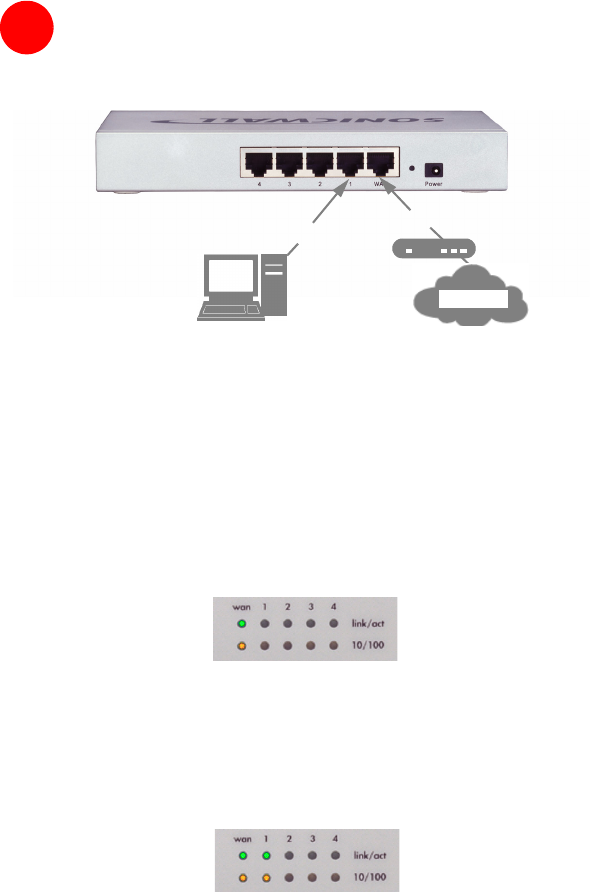
SonicWALL TZ 150 Wireless Getting Started Guide Page 5
Connecting the
SonicWALL TZ 150 Wireless
Connecting the Ethernet Cables
1. Connect one end of an Ethernet cable to your Internet
connection, such as a DSL modem or cable modem.
This cable may already be connected between your computer
and your modem. If so, disconnect it from your computer, and
leave it connected to the internet.
2. Connect the other end of the cable to the WAN port on the back
of your SonicWALL TZ 150 Wireless.
The WAN LEDs on the front panel light up indicating an active
connection.
3. Connect one end of an Ethernet cable to the computer you are
using to manage the SonicWALL TZ 150 Wireless.
4. Connect the other end of the cable to port # 1 on the back of your
SonicWALL TZ 150 Wireless.
The port # 1 LEDs on the front panel light up indicating an active
connection.
3
Management
Station
LAN 1 WAN DSL or Cable
Modem
Internet
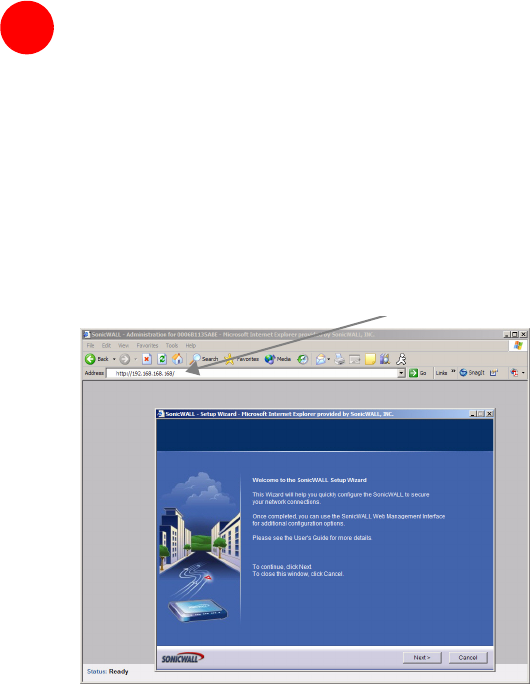
Page 6
Accessing the Management Interface
To access the Web-based management interface of the
SonicWALL TZ 150 Wireless:
1. On the computer you have connected to port # 1, Start your Web
browser.
Alert: Turn off pop-up blocking software before accessing the
SonicWALL management interface.
Your Web browser must support Java and HTTP uploads.
Internet Explorer 5.0 or higher or Netscape Navigator 4.7 or
higher are recommended.
2. Enter 192.168.168.168 in the Location or Address field.
3. The SonicWALL Setup Wizard launches and guides you
through the configuration and setup of your
SonicWALL TZ 150 Wireless.
4
SonicWALL TZ 150 Wireless Getting Started Guide Page 7
If the SonicWALL Setup Wizard Does Not Appear
If you cannot connect to the SonicWALL TZ 150 Wireless or the
Setup Wizard does not display, verify the following
configurations:
• Did you correctly enter the SonicWALL TZ 150 Wireless
management IP address in your Web browser?
• Is your computer running pop-up blocking software?
• Are the Local Area Connection settings on your computer set
to obtain an IP address dynamically (DHCP)? see Step 7,
“Connecting Computers to Your
SonicWALL TZ 150 Wireless” on page 26 for instructions on
changing your Local Area Connection settings.
• Do you have the Ethernet cable connected to your computer
and to port 1 on your SonicWALL TZ 150 Wireless?
• Some browsers may not launch the Setup Wizard
automatically. In this case, log into
SonicWALL TZ 150 Wireless using “Admin” as the user
name and “password” as the password. After you log in,
click the Wizards button on the
System > Status page. Select Setup to begin configuring
your SonicWALL TZ 150 Wireless.
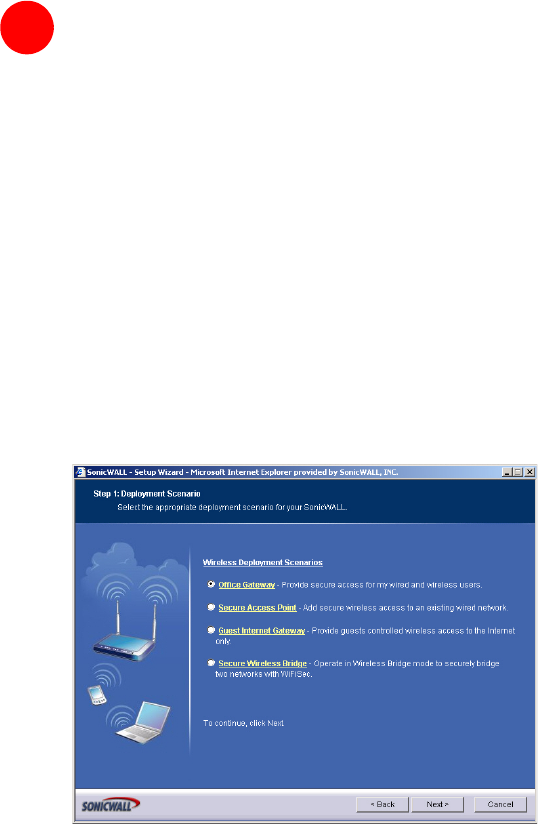
Page 8
Using the SonicWALL Setup Wizard
The SonicWALL Setup Wizard provides user-guided instructions for
configuring your SonicWALL TZ 150 Wireless.
Note: Make sure you have any required ISP information to complete
the configuration before using the Setup Wizard. See the list of
required information in Step 1, “Collect Required Information” on
page 3.
Tip: If you do not know what type of Internet connection you have,
contact your ISP. In addition, the SonicWALL Setup Wizard will
attempt to detect your connection settings. You will see what is
automatically selected in Setup Wizard page 4, WAN Network Mode
Welcome - Click Next to begin.
1. Deployment Scenario - select the wireless deployment scenario
that best matches your deployment requirements. Clicking on the
deployment scenario link displays a diagram of the deployment to
show how the scenario is best used.
5
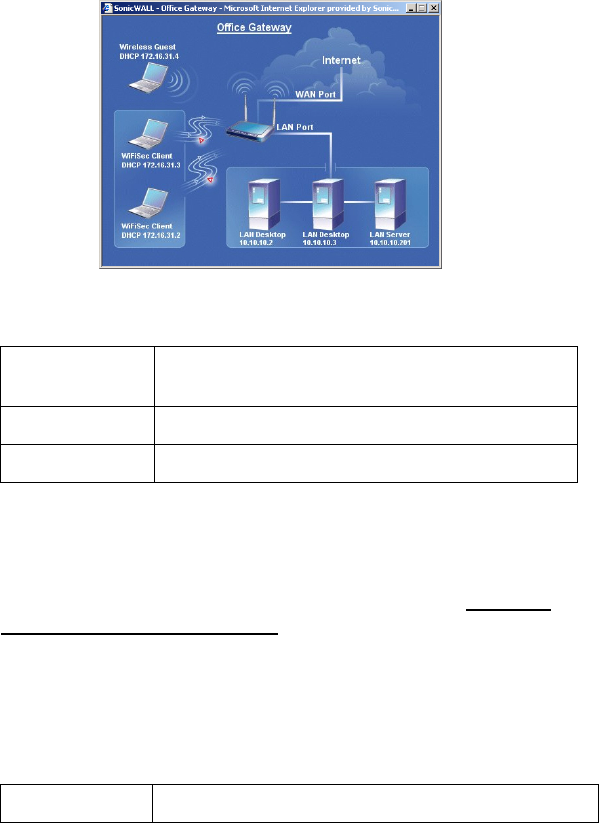
SonicWALL TZ 150 Wireless Getting Started Guide Page 9
Select Office Gateway, which is a commonly used wireless
deployment for LAN and WLAN to Internet connectivity.
2. Change Password - Change the administrative password. This
is the password for the admin account.
!
Note: Keep your new password in a safe place. If you lose your
password, you will have to reset the SonicWALL TZ 150 Wireless
to factory settings, losing your configuration. For instructions on
resetting your SonicWALL TZ 150 Wireless, See the SonicOS
Standard Administrator’s Guide available on the SonicWALL
Resource CD and on the Web at:
<http://www.sonicwall.com/services/documentation.html>
Click Next.
3. Change Time Zone - Change the Time Zone setting to your
local time zone.
Old Password Should be populated with the default password,
password.
New Password Enter your new password.
Confirm Re-enter your new password.
Time Zone Select the time zone for your location from the list.

Page 10
Click Next.
!
Note: It is important that you set the time zone correctly before
you register your SonicWALL TZ 150 Wireless.
4. WAN Network Mode - The Setup Wizard automatically detects
most networking modes. If it does not detect the networking
mode, you may have a Static IP Address. See Step 1, “Collect
Required Information” on page 3.
Confirm the selection or select the correct type of network
connection for your network.
Click on the yellow link for a networking type to see a definition.
Click Next.
Automatically
adjust clock
for daylight
saving time
Check this if you live in an area that observes Day-
light Savings Time.
Static IP Select Static IP if you want to give the
SonicWALL TZ 150 Wireless a specific, unchanging
IP address.
DHCP Select DHCP if your ISP assigns your computer a
dynamic IP Address. DHCP is commonly used with
cable modems.
PPPoE Select PPPoE if your ISP requires a username and
password to establish a connection and assign a
dynamic address. PPPoE is commonly used with
DSL modems.
PPTP Select PPTP if you dial into a specific server and log
into a VPN to establish a connection. With PPTP,
you can have either a static or dynamic IP Address.

SonicWALL TZ 150 Wireless Getting Started Guide Page 11
5. WAN Network Mode - The second WAN network mode page
configures your WAN settings for the selection you made in the
previous page.
WAN Network Mode: NAT Enabled (Static IP)
Click Next.
WAN Network Mode: NAT with DHCP Client
You do not need to enter any WAN networking settings. The
network settings are provisioned automatically from a DHCP
server.
Click Next.
SonicWALL
WAN IP
Address
Enter a single, static IP address. This must be in
the correct address range for your ISP.
WAN Sub-
net Mask
Enter the subnet mask for your network, for
example, 255.255.255.0.
Gateway
(Router)
Address
Enter the IP address of your internet gateway.
DNS Server
Address
Enter the IP address of the DNS server for your
network.
DNS Server
Address #2
(optional)
You can enter a secondary, back-up DNS server
to use if the first one fails.

Page 12
WAN Network Mode - NAT with PPPoE Client
Click Next.
WAN Network Mode: NAT with PPTP Client
Obtain an
IP Address
Automatically
Select this if your ISP assigns you a dynamic
IP address.
Use the
following
IP Address
Select this if your ISP has assigned you a
static IP address, and enter the address.
PPPoE User
Name
Enter the user name for your Internet account.
The username usually includes “@” and the
domain name, for example, joe.user@ispgate-
way.net.
PPPoE
Password
Enter the password for your internet account.
Inactivity
Disconnect
(minutes)
Check this box if you want the
SonicWALL TZ 150 Wireless to disconnect
from the Internet if there is no traffic for the
number of minutes you enter.
PPTP Server
IP Address
Enter the address of the server you are con-
necting to.
PPTP User
Name
Enter your network user name.
PPTP Pass-
word
Enter your network password.
Obtain an
IP Address
Automatically
Select this if the server assigns you a dynamic
IP address.
Use the
following
IP Address
Check this if you have been given a static IP
address, and fill in the following three fields.

SonicWALL TZ 150 Wireless Getting Started Guide Page 13
Click Next.
6. LAN Settings - The LAN Settings page configures your LAN
interface. These settings apply to all twenty-four LAN ports.
By default, your SonicWALL TZ 150 Wireless is configured with a
LAN network IP address, 192.168.168.168, and subnet mask,
255.255.255.0, that will work well for most installations. In most
cases, leave the default LAN IP address and subnet mask
unchanged.
!
Note: The LAN IP address is the address you will use to access
the SonicWALL TZ 150 Wireless management interface.
Click Next.
SonicWALL
WAN
IP Address
Enter the static IP address for your connection.
WAN/DMZ
Subnet Mask
Enter the subnet mask for your connection.
Gateway
(Router)
Address
Enter the address of your Internet Gateway.
SonicWALL
LAN
IP Address
Accept the default IP address or enter a new IP
address of the LAN interface.
LAN
Subnet Mask
Accept the default, or enter a subnet mask for your
LAN.
Enable
Windows
Networking
Support
Leave this option checked if you plan to have more
than one Windows computer, Windows Networking
allows them to communicate with each other. If you
have only one Windows computer or have comput-
ers with other operating systems, Windows Net-
working has no effect.

Page 14
7. LAN DHCP Settings - The LAN DHCP Settings page allows you
to select whether or not to use the DHCP Server in the
SonicWALL TZ 150 Wireless to automatically distribute IP
addressing information to computers and other network devices
on your LAN.
Click Next.
8. WLAN 802.11b/g Settings - The WLAN 802.11b/g Settings page
allows you to configure your wireless network settings.
Click Next.
9. WiFiSec - WiFiSec is a security standard that uses an IPSec
VPN to secure wireless network connections. The WiFiSec page
Enable
DHCP
Server on
LAN
Leave checkbox checked to use the DHCP server in
the SonicWALL TZ 150 Wireless.
Do not use select this option if you already have a
DHCP server on your network, or if you want to require
your network clients to have static IP addresses.
LAN
Address
Range
If you enabled the DHCP Server, enter a range of IP
addresses in the same subnet as the LAN IP address.
Leave the default range unchanged if you accepted the
default LAN IP address and subnet mask settings in
the previous page.
SSID Enter a unique name your wireless clients will use to
identify the SonicWALL TZ 150 Wireless connection.
Radio
Mode
Select which radio transmission standard you want to
use. The default, Mixed, works for most office and
home settings.
Country
Code
Select the country where you are deploying this
SonicWALL TZ 150 Wireless
Channel Select the broadcast channel you want the
SonicWALL TZ 150 Wireless to use. The default,
AutoChannel automatically detects the channel with
the least interference to use.

SonicWALL TZ 150 Wireless Getting Started Guide Page 15
allows you to create a first VPN user to connect securely to your
wireless network.
Click Next.
Note: You add additional users in the Users> Settings page in
the SonicWALL TZ 150 Wireless security appliance’s
Management Interface. See the SonicOS Standard
Administrator’s Guide for instructions.
10. Wireless Guest Services - Wireless Guest services allow guest
users to connect through your wireless network to the internet
without any access to your network.
User
Name
Enter a user name for the VPN user.
Password Enter a unique password for the user.
Confirm
Password
Re-enter the password.
Enable
Wireless
Guest
Services
Check to enable Wireless Guest Services on your
network.
Account
Name
Enter the account name your guest users must use to
log into Wireless Guest Services.
Account
Password
Enter a password for the guest account.
Confirm
Password
Re-enter the password
Account
Lifetime
Specify how long this account may exist before you
need to regenerate it.
Session
Lifetime
Specify how long a guest user may be logged in.
Comment A brief description of the guest account.
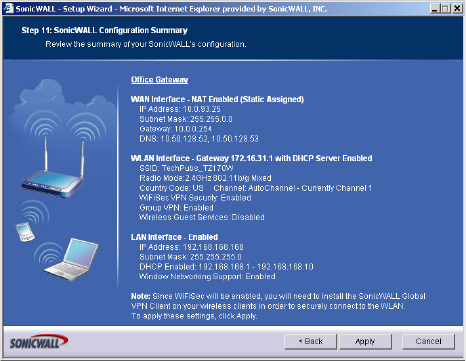
Page 16
Click Next.
11. SonicWALL Configuration Summary - Displays your network
configuration information.
Setup Wizard Complete - your SonicWALL TZ 150 Wireless is now
successfully configured for LAN, Wireless, and Internet access. Click
Restart to complete the configuration process.
12. Test your connection: After the SonicWALL TZ 150 Wireless
reboots, open a Web browser, and go to <http://
www.sonicwall.com>
If you can view the SonicWALL home page, you have configured
everything correctly.
If you cannot view the SonicWALL home page try a second URL.
If you still cannot view a Web page, return to step 4, “Accessing
the Management Interface” on page 6, log in as “admin” with your
administrative password, and click on the Wizards button in the
top right corner of the management interface to restart the wizard.

SonicWALL TZ 150 Wireless Getting Started Guide Page 17
Registering Your
SonicWALL TZ 150 Wireless
Once you’ve established your Internet connection, it is recommended
you register your SonicWALL security appliance at
mySonicWALL.com. Registering your SonicWALL security appliance
provides the following benefits:
• Try a FREE 30-day trial of SonicWALL SonicWALL's
Gateway Anti-Virus/Intrusion Prevention Service,
Content Filtering Service, and Network Anti-Virus
• Activate SonicWALL security services
• Access SonicOS firmware updates
• Get SonicWALL technical support
Alert: The Time Zone and DNS settings on your
SonicWALL TZ 150 Wireless must be set correctly before registering
your security appliance. See Step 5, “Using the SonicWALL Setup
Wizard” on page 8 for instructions on setting the Time Zone and DNS
settings.
Before You Register
You need a mySonicWALL.com account to register the
SonicWALL TZ 150 Wireless. You can create a new
mySonicWALL.com account directly from the SonicWALL
management interface.
Alert: Make sure the DNS and Time settings on your
SonicWALL TZ 150 Wireless are correct when you register the
device. Configure Time settings in the System > Time page.
Configure DNS settings in the Edit Interface window from the
Network > Interfaces page.
Note: mySonicWALL.com registration information is not sold or
shared with any other company.
6
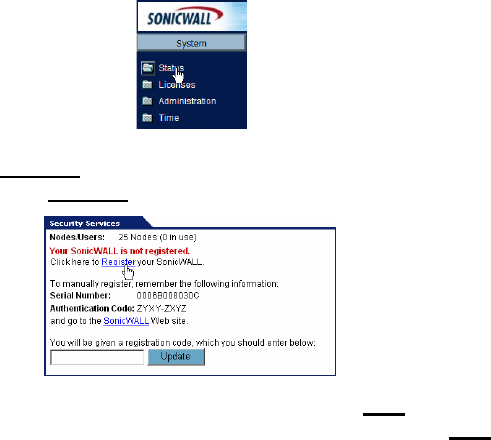
Page 18
Creating a mySonicWALL.com Account
Creating a mySonicWALL.com account is fast, simple, and FREE.
Simply complete an online registration form in the
SonicWALL TZ 150 Wireless management interface.
If you already have a mysonicWALL.com account, go to “Registering
Your SonicWALL TZ 150 Wireless” on page 19 to register your
appliance.
1. If you are not logged into the SonicWALL TZ 150 Wireless
management interface log in with the username admin and the
administrative password you set in the Setup Wizard.
2. If the System > Status page is not displaying in the management
interface, click System in the left-navigation menu, and then click
Status.
3. On the System > Status page, in the Security Services section,
click the Register link in Your SonicWALL is not registered.
Click here to Register your SonicWALL.
4. In the mySonicWALL.com Login page, click the here link in “If
you do not have a mySonicWALL account, please click here
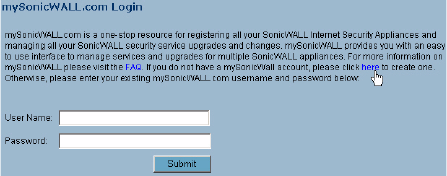
SonicWALL TZ 150 Wireless Getting Started Guide Page 19
to create one.” The mySonicWALL.com account form is
displayed.
5. In the MySonicWall Account page, enter in your information in
the Account Information, Personal Information and
Preferences fields. All fields marked with an asterisk (*) are
required fields.
Note: Remember your username and password to access your
mySonicWALL.com account.
6. Click Submit after completing the MySonicWALL Account form.
7. When the mySonicWALL.com server has finished processing
your account, you will see a page saying that your account has
been created. Click Continue.
Congratulations. Your mySonicWALL.com account is activated.
Now you need to log into mySonicWALL.com to register your
SonicWALL TZ 150 Wireless.
Registering Your SonicWALL TZ 150 Wireless
1. If you are not logged into the SonicWALL TZ 150 Wireless
management interface, log in with the username admin and the
administrative password you set in the Setup Wizard.
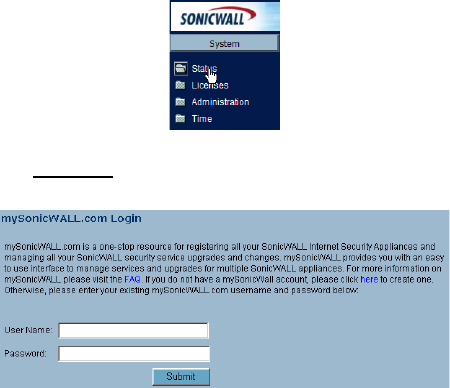
Page 20
2. If the System > Status page is not displaying in the management
interface, click System in the left-navigation menu, and then click
Status.
3. On the System > Status page, in the Security Services section,
click the Register link. The mySonicWALL.com Login page is
displayed.
4. Enter your mySonicWALL.com account username and password
in the User Name and Password fields, then click Submit.
5. The next several pages inform you about the free trials available
to you for SonicWALL’s Security Services:
•Gateway Anti-virus - Delivers real-time virus protection for
your entire network
•Complete Anti-virus - Delivers desktop and server
anti-virus protection
•Premium Content Filtering Service - Enhances productivity
by limiting access to objectionable Web content
•Intrusion Prevention Service - Protects your network
against worms, Trojans and application layer attacks
Click Continue on each page.
6. At the top of the Product Survey page, Enter a “friendly name”
for your SonicWALL content security appliance in the Friendly
Name field. The friendly name allows you to easily identify your
SonicWALL TZ 150 Wireless Getting Started Guide Page 21
SonicWALL content security appliance in your
mySonicWALL.com account.
7. Please complete the Product Survey. SonicWALL uses this
information to further tailor services to fit your needs.
8. Click Submit.
9. When the mySonicWALL.com server has finished processing
your registration, you will see a page informing you that your
SonicWALL TZ 150 Wireless appliance is registered. Click
Continue, and the System > Licenses page is displayed
showing the available security services. You can activate the
services from this page now or at any time in the future.
Congratulations
Your SonicWALL TZ 150 Wireless is now fully operational.
You can continue with this Getting Started Guide to:
• Set up computers on your network
• Mount your SonicWALL TZ 150 Wireless on a wall or to any
vertical surface
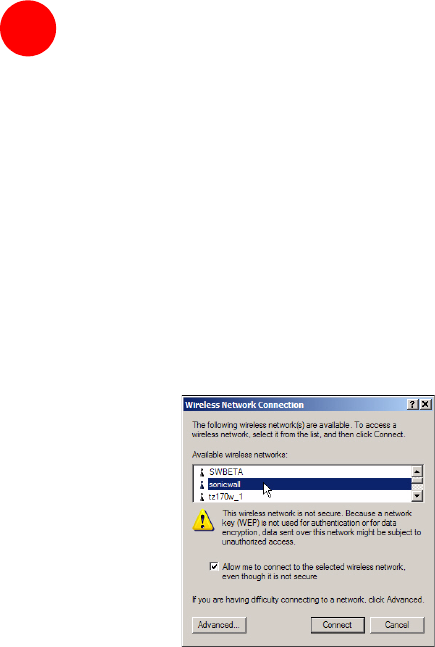
Page 22
Connecting Wireless Clients to the
SonicWALL TZ 150 Wireless
For wireless clients to connect to your WLAN zone, they
need:
• A wireless network card installed and configured for the
SonicWALL TZ 150 Wireless’ SSID
• SonicWALL GVC or SonicWALL GSC installed and
configured for a secure wireless connection
Connecting to the Wireless Network
You connect to the wireless network according to the requirements of
your client operating system. Your wireless client may automatically
detect and display the SonicWALL TZ 150 Wireless’ SSID in a list of
available wireless networks or you may need to manually configure
your wireless card with the SonicWALL TZ 150 Wireless’ SSID.
Establishing Secure Wireless Connections
For a wireless client to securely connect to the
SonicWALL TZ 150 Wireless using WiFiSec, the SonicWALL Global
VPN Client (GVC) and SonicWALL Global Security Client (GSC)
must be installed and configured. Installing and configuring
SonicWALL GVC involves the following procedures:
• “Installing the SonicWALL GVC or SonicWALL GSC Using the
Setup Wizard” on page 23
7
SonicWALL TZ 150 Wireless Getting Started Guide Page 23
• “Creating an Office Gateway Connection Profile Using the New
Connection Wizard” on page 24
• “Establishing a WiFiSec VPN Connection Using the WLAN
GroupVPN Policy” on page 25
Installing the SonicWALL GVC or SonicWALL GSC Using
the Setup Wizard
If necessary, install the SonicWALL GVC. It is available either as the
standalone SonicWALL GVC or as the SonicWALL GVC component
of SonicWALL GSC. Follow the instructions in the Setup Wizard to
install SonicWALL GVC or SonicWALL GSC.
Note: SonicWALL GVC is free to use for WiFiSec secured wireless
connections. For remote VPN access through a WAN port, you must
have a GVC Client License. For complete product documentation on
SonicWALL GVC or SonicWALL GSC, see your Resource CD or visit
the SonicWALL Web site at
<http://www.sonicwall.com/services/documentation.html>.
Tip: You can download the latest GVC installer at SonicWALL’s
product Web site at
<http://help.mysonicwall.com/applications/vpnclient>.
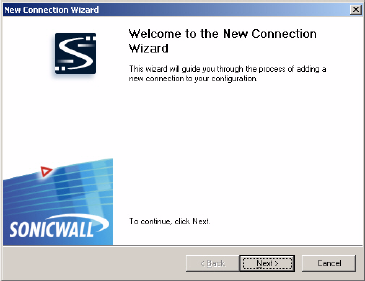
Page 24
Creating an Office Gateway Connection Profile Using the
New Connection Wizard
1. In your Windows Start Menu, Choose Start > Programs >
SonicWALL Global VPN Client. The first time you open
SonicWALL GVC, the New Connection Wizard automatically
launches.
If the New Connection Wizard does not display, click the New
Connection Wizard icon on the far left side of the toolbar to
launch it. Click Next.
2. In the Choose Scenario page, select Office Gateway. Click
Next.
3. In the Completing the New Connection Wizard page select
any of the following options:
• Select Create a desktop shortcut to this connection, if you
want to create a shortcut icon on your desktop for this VPN
connection.
• Select Enable this connection when the program is
launched, if you want to automatically establish this VPN
connection when you launch the SonicWALL Global VPN
Client.
4. Click Finish. The new VPN connection policy appears in the
SonicWALL Global VPN Client window.
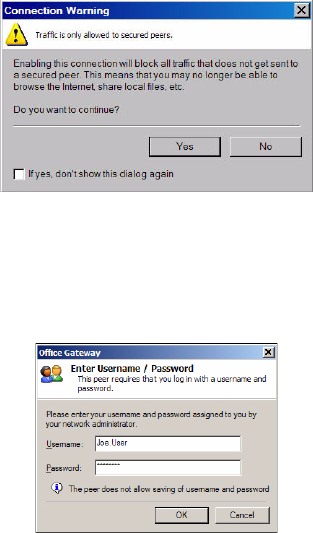
SonicWALL TZ 150 Wireless Getting Started Guide Page 25
Establishing a WiFiSec VPN Connection Using the WLAN
GroupVPN Policy
1. In the SonicWALL Global VPN Client window, double-click the
Office Gateway profile. The Connection Warning dialog box is
displayed, which informs you that all traffic that is not going to the
secured VPN gateway will be blocked.
2. Click Yes to continue.
3. In the Enter Username/Password dialog box, enter the
authentication credentials for the user configured on the
SonicWALL security appliance’s local user database for access
to the WLAN GroupVPN.
4. Click OK. You now have secure wireless access to all the
networks, subnets, and addresses you assigned the user access.
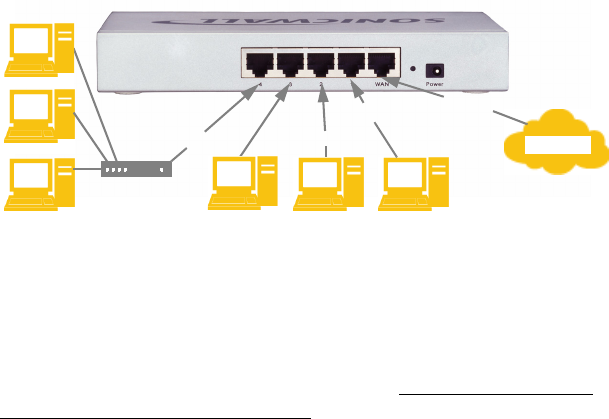
Page 26
Connecting Computers to Your
SonicWALL TZ 150 Wireless
You can attach up to ten computers to your
SonicWALL TZ 150 Wireless.
Configuring Computers for Your Network with DHCP
If you enabled the DHCP Server in the Setup Wizard, each computer
on your network must be configured to obtain its IP address
dynamically. The following steps provide instruction on changing the
Local Area Connection settings for several versions of Windows.
Note: If you are not using DHCP, refer to the SonicWALL SonicOS
Standard 3.0 Administrator’s Guide available on the SonicWALL
Resource CD and on the SonicWALL’s Documentation Web Site at:
<http://www.sonicwall.com/services/documentation.html>.
Windows XP
1. Open the Local Area Connection Properties window
(Start > Settings > Network Connections on most versions of
Windows XP).
2. Right click on the Local Area Connection icon, and choose
Properties.
3. In the list of connection items, select Internet Protocol (TCP/IP)
and click Properties.
4. Select Obtain an IP address automatically.
5. Select Obtain DNS Server automatically.
Internet
WAN
LAN 3
LAN 2LAN 4
LAN 1
Hub
SonicWALL TZ 150 Wireless Getting Started Guide Page 27
6. Click OK and then OK again to apply the settings.
Windows 2000
1. From your Windows Start menu, select Settings.
2. Open Network and Dial-up Connections.
3. Right click on the Local Area Connection icon, and choose
Properties.
4. Highlight Internet Protocol (TCP/IP) and click Properties.
5. Select Obtain an IP address automatically.
6. Select Obtain DNS Server automatically.
7. Click OK and then OK again to apply the settings.
Windows NT
1. From the Start list, highlight Settings and then select Control
Panel.
2. Open Network.
3. Double-click TCP/IP in the TCP/IP Properties window.
4. Select Obtain an IP address automatically.
5. Click DNS at the top of the window.
6. Select Obtain DNS Server automatically.
7. Click OK, and then click OK again.
8. Restart the computer to apply the settings.
Windows 98
1. In the Start menu, select Settings and then select Control
Panel.
2. Open Network.
3. Double-click TCP/IP in the TCP/IP Properties window.
4. Select Obtain IP Address automatically.
5. Click DNS Configuration.
6. Select Obtain DNS Server automatically.
7. Click OK, and then click OK again.
8. Restart the computer to apply the settings.
Page 28
Mounting the SonicWALL TZ 150 Wireless
You can mount your SonicWALL TZ 150 Wireless on a wall or any
vertical surface. Use the template on the next page as a guide for
placing the mounting screws.
1. Using the template on the next page, attach two screws to the
surface where you want to mount the security appliance.
The mounting screws should have a head between 3/16” and
1/4” in diameter.
The mounting screws should stick approximately 1/8” out from
the surface.
2. Slide the slots in the back of the SonicWALL TZ 150 Wireless
over the heads of the mounting screws and then slide the security
appliance down to secure it in place.

SonicWALL TZ 150 Wireless Getting Started Guide Page 29
SonicWALL TZ 150 Wireless Mounting Template
Align front
corner here
Attach mounting screw here
Considerations for Mounting the SonicWALL TZ 150 Wireless
• Mount in a location away from direct sunlight and sources of heat.
A maximum ambient temperature of 104º F (40º C) is
recommended.
• Route cables away from power lines, fluorescent lighting fixtures,
and sources of noise such as radios, transmitters, and broadband
amplifiers
• Ensure that no water or excessive moisture can enter the unit.
• Allow unrestricted airflow around the unit and through the vents
on the side of the unit. A minimum of 1 inch (25.44mm) clearance
is recommended.
Attach mounting screw here
Page 30
SonicWALL TZ 150 Wireless Getting Started Guide Page 31
Glossary of Networking Terms
•Default Gateway - A device on an internetwork that forwards
packets to another network.
•DHCP - Dynamic Host Configuration Protocol allocates IP
addresses to computers on the network automatically without
assigning a computer a static (fixed) IP address.
•DNS - A Domain Name System is a hierarchical naming system
that resolves a domain name with its associated IP address. A
DNS server looks up the name of a computer and finds the
corresponding IP address. This allows users to access hosts
using friendly text-based names instead of IP addresses. These
names are called fully qualified domain names (FQDN).
•IP Address - An Internet Protocol Address is a thirty-two bit
number that identifies a computer or other resource on the
Internet or on any TCP/IP network. The number is usually
expressed as four numbers from 0 to 255 separated by periods,
for example, 172.16.31.254.
•LAN - A Local Area Network is typically a group of computers
located at a single location, and is commonly based on the
Ethernet architecture.
•NAT - Network Address Translation is an internet standard that
allows your local network to use private IP addresses, which are
not recognized on the Internet. The IP address used for the router
is the only routable IP address. The computers behind the NAT
can access the Internet through the router, but Internet users
cannot access the computers behind the router.
•Packet - A unit of information transmitted over the internet or
within any TCP/IP network. Packets have a header, which
contains information about the source, destination, and protocol
to be used for the data, and a body, which contains the data being
transmitted.
•PPPoE - The Point to Point Protocol over Ethernet supports the
transmission of network packets over an analog phone line.
•Private IP Address - An IP address for a resource in your
network that is not known or published outside the zone (for
example LAN) where it is located.
Page 32
•Public IP Address - An IP address for a resource in your
network that is published outside your network to the WAN.
•Router - A device that routes data between networks through IP
address information in the header of the IP packet. A router
forwards packets to other routers until the packets reach their
destination. The Internet is the largest example of a routed
network.
•Subnet - A portion of a network. Each subnet within a network
shares a common network address and is uniquely identified by a
subnetwork number.
•Subnet Mask - A 32-bit number used to separate the network
and host sections of an IP address. A subnet mask subdivides an
IP network into smaller pieces. An example of a subnet mask
might be 255.255.255.248 for subnet with only eight IP
addresses.
•TCP/IP - Transmission Control Protocol/Internet Protocol is the
basic communication protocol of the Internet. It supports sending
information in packets, and identifies each device with a unique
numeric IP address.
•VPN - A Virtual Private Network is a virtual network that encrypts
data and sends it privately over the Internet to protect sensitive
information.
•WAN - A Wide Area Network is a geographically distributed
network composed of multiple networks joined into a single large
network. The Internet is a global WAN.

SonicWALL TZ 150 Wireless Getting Started Guide Page 33
SonicWALL TZ 150 Wireless Security
Appliance Regulatory Statement and Safety
Instructions
Note: Detailed regulatory information can be found in the electronic
file, “SonicWALL_TZ_50_Regulatory_Statement.pdf,” located on the
SonicWALL Resource CD provided with the unit or on the
SonicWALL Web site: <http://www.sonicwall.com>.
Cable Connections
All Models
All Ethernet and RS232 (Console) cables are designed for intra-
building connection to other equipment. Do not connect these
ports directly to communication wiring or other wiring that exits
the building where the SonicWALL is located.
Power Supply Information Models APL15-03B
If you need to order a power supply for your
SonicWALL TZ 150 Wireless, please contact SonicWALL Technical
Support at 408-752-7819 for a replacement. This product should only
be used with a UL listed power supply marked “Class 2” or “LPS”,
with an output rated 12 VDC, minimum 1.66 A.
Considerations for Mounting the APL15-03B
See the “SonicWALL TZ 150 Wireless Mounting Template” on
page 29.
Regulatory Model/Type Product Name
APL15-03B, TZ 50
Page 34
Copyright Notice
© 2004 SonicWALL, Inc.
All rights reserved.
Under the copyright laws, this manual or the software described
within, can not be copied, in whole or part, without the written consent
of the manufacturer, except in the normal use of the software to make
a backup copy. The same proprietary and copyright notices must be
affixed to any permitted copies as were affixed to the original. This
exception does not allow copies to be made for others, whether or not
sold, but all of the material purchased (with all backup copies) can be
sold, given, or loaned to another person. Under the law, copying
includes translating into another language or format.
Specifications and descriptions subject to change without notice.
Trademarks
SonicWALL is a registered trademark of SonicWALL, Inc.
Microsoft Windows 98, Windows NT, Windows 2000, Windows XP,
Windows Server 2003, Internet Explorer, and Active Directory are
trademarks or registered trademarks of Microsoft Corporation.
Netscape is a registered trademark of Netscape Communications
Corporation in the U.S. and other countries. Netscape Navigator and
Netscape Communicator are also trademarks of Netscape
Communications Corporation and may be registered outside the U.S.
Adobe, Acrobat, and Acrobat Reader are either registered
trademarks or trademarks of Adobe Systems Incorporated in the U.S.
and/or other countries.
Other product and company names mentioned herein may be
trademarks and/or registered trademarks of their respective
companies and are the sole property of their respective
manufacturers.
SonicWALL TZ 150 Wireless Getting Started Guide Page 35
Notes
Page 36
Notes